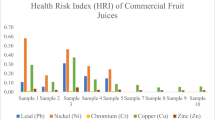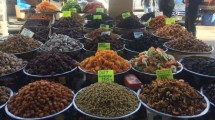Abstract
The consumption rate of fruit juices has rapidly increased in the past years. In this study, the detailed discussion of method validation and uncertainty calculations and then the evaluation of concentrations of Ag, As, Be, Bi, Cd, Co, Pb, Se, and V determined in 42 commercial fruit juice samples by using inductively coupled plasma mass spectrometry (ICP-MS) were presented. The samples were digested with nitric acid and hydrogen peroxide in a microwave oven. In order to verify the recovery of the proposed method, standard reference material was used. The recovery values changed between 83 and 118 %. The average precision values for all elements were determined as the relative standard deviation RSD (%) in the range of 1.3 and 2.9 %. Applying the bottom-up method, it was found that the main contributions to the combined uncertainty came from the calibration curve and the method recovery. The concentrations of all metals did not exceed the international and Turkish codex values.

Similar content being viewed by others
References
Alwakeel SS, Al-Humaidi EAH (2008) Microbial growth and chemical analysis of mineral contents in bottled fruit juices and drinks in Riyadh, Saudi Arabia. Res J Microbiol 3:319–325
Codex Alimentarius, Codex general standard for contaminants and toxins in food and feed (Codex Stan 193–1995) pages 1–44. Adopted 1995; Revised 1997, 2006, 2008, 2009; Amended 2009.
D’llio S, Alessandrelli M, Cresti R, Forte G, Caroli S (2002) Arsenic content of various types of rice as determined by plasma-based techniques. Microchem J 73:195–201
Doğan G, Güllü G, Tuncel G (2008) Sources and source regions affecting the aerosol composition of the Eastern Mediterranean. Microchem J 88:142–149
Eğilli EI (1999) Nötron aktivasyon analizi ile tayin edilen eser elementleri kullanarak kömürlerin hava kalitesine etkisinin değerlendirilmesi (in Turkish). Ph. D. Thesis, Istanbul Technical University, Turkey
Eisele TA, Drake SR (2005) The partial compositional characteristics of apple juice from 175 apple varieties. J Food Compos Anal 18:213–221
Ellison SLR, Williams A (eds) (2012) Eurachem/Citac Guide: Quantifying uncertainty in analytical measurement, 3rd edn. Eurachem/Citac Guide CG4
Environmental Protection Agency-EPA (1992) Guidance for methods development and methods validation for the RCRA program. Development and validation of SW-846 methods. Phase 2: Formal validation
Froes RES, Neto WB, Couto e Silva NO, Naveria RLP, Nascentes CC, Borba da Silva JB (2009) Multivariate optimization by exploratory analysis applied to the determination of microelements in fruit juice by inductively coupled plasma optical emission spectrometry. Spectrochim Acta B 64:619–622
Goldhaber SB (2003) Trace element risk assessment: essentiality vs. toxicity. Regul Toxicol Pharmacol 38:232–242
Gutzeit D, Winterhalter P, Jerz G (2008) Nutritional assessment of processing effects on major and trace element content in sea buckthorn juice (Hippophae rhamnoides L. ssp. rhamnoides). J Food Sci 73:H96–H102
Harmankaya M, Gezgin S, Ozcan MM (2012) Comparative evaluation of some macro- and micro-element and heavy metal contents in commercial fruit juices. Environ Monit Assess 184:5415–5420
Hua Z, Zhen-Yu W, Xin Y, Hai-Tian Z, Ying-Chun Z, Ai-Jun D, Jing JWJ (2014) Determination of free amino acids and 18 elements in freeze-dried strawberry and blueberry fruit using an Amino Acid Analyzer and ICP-MS with micro-wave digestion. Food Chem 147:189–194
Ince H, Coskun N (2008) Determination of heavy metals in fruit juices by flame atomic absorption spectrometry. Asian J Chem 20:3537–3542
Jalbani N, Kazi TG, Arain RM, Jamali MK, Afridi HI, Sarfraz RA (2006) Application of factorial design in optimization of ultrasonic-assisted extraction of aluminum in juices and soft drinks. Talanta 70:307–314
Ji-Luan C, Ji-hong W, Ying J, Xiao-song H (2009) Determination of mineral elements in eight pear varieties by ICP-MS after microwave-assisted digestion. Spectrosc Spectr Anal 29:496–498
Juranovic Cindric I, Zeiner M, Kroppl M, Stingeder G (2011) Comparison of sample preparation methods for the ICP-AES determination of minor and major elements in clarified apple juices. Microchem J 99:364–369
Karakaş D (1999) Determination of the European contribution on the aerosol composition in the Black Sea basin and investigation of transport mechanism. Ph. D. Thesis, Department of Chemistry, Middle East Technical University, Ankara, Turkey
Magdas DA, Dehelean A, Puscas R (2012) Isotopic and elemental determination in some Romanian apple fruit juices. Sci World J 878242:7
Millour S, Noel L, Kadar A, Chekri R, Vastel C, Guerin T (2011) Simultaneous analysis of 21 elements in foodstuffs by ICP-MS after closed-vessel microwave digestion: method validation. J Food Compos Anal 24:111–120
Nascentes CC, Arruda MAZ, Nogueira ARA, Nobrega JA (2004) Direct determination of Cu and Zn in fruit juices and bovine milk by thermospray flame furnace atomic absorption spectrometry. Talanta 64:912–917
Oliveira AP, Neto JAG, Nobrega JA, Correia PRM, Oliveira PV (2005) Determination of selenium in nutritionally relevant foods by graphite furnace atomic absorption spectrometry using arsenic as internal standard. Food Chem 93:355–360
Onianwa PC, Adetola IG, Iwegbue CMA, Ojo MF, Tella OO (1999) Trace heavy metals composition of some Nigerian beverages and food drinks. Food Chem 66:275–279
Pohl P, Prusisz B (2006) Fractionation of calcium and magnesium in honeys, juices and tea infusions by ion exchange and flame atomic absorption spectrometry. Talanta 69:1227–1233
Simpkins WA, Louie H, Wu M, Harrison M, Goldenberg D (2000) Trace elements in Australian orange juice and other products. Food Chem 71:423–433
Szymczcha-Madeja A, Welna M (2013) Evaluation of simple and fast method for the multi-elemental analysis in commercial fruit juice samples using atomic emission spectrometry. Food Chem 141:3466–3472
Szymczcha-Madeja A, Welna M, Jedryczko D, Pohl P (2014) Developments and strategies in the spectrochemical elemental analysis of fruit juices. Trends Anal Chem 55:68–80
Tahvonen R (1998) Lead and cadmium in beverages consumed in Finland. Food Addit Contam 15:446–450
Taylor VF, Longerich HP, Grenough JD (2003) Multielement analysis of Canadian wines by inductively coupled plasma mass spectrometry (ICP-MS) and multivariate statistics. J Agric Food Chem 51:856–860
Toaldo IM, Fogolari O, Cadore-Pimental G, Santos de Gois J, Borges DLG, Caliari V, Bordignon-Luiz M (2013) Effect of grape seeds on the polyphenol bioactive content and elemental composition by ICP-MS of grape juices from Vitis labrusca L. Food Sci Technol 53:1–8
Tormen L, Torres DP, Dittert IM, Arau´jo RGO, Frescura VLA, Curtius AJ (2011) Rapid assessment of metal contamination in commercial fruit juices by inductively coupled mass spectrometry after a simple dilution. J Food Compos Anal 24:95–102
Turkish Official Gazette, Regulation of setting maximum levels for certain contaminants in foodstuffs. Iss:24885, 2002/63
Williams AB, Ayejuyo OO, Ogunyale AF (2009) Trace metal levels in fruit juices and carbonated beverages in Nigeria. Environ Monit Assess 156:303–306
Yenisoy-Karakaş S (2012) Estimation of uncertainties of the method to determine the concentrations of Cd, Cu, Fe, Pb, Sn and Zn in tomato paste samples analysed by high resolution ICP-MS. Food Chem 132:1555–1561
Yenisoy-Karakaş S, Tuncel SG (2008) Source apportionment of atmospheric trace element deposition in western Turkey. Environ Eng Sci 25:1263–1271
Conflict of Interest
Serpil Kılıç declares that she has no conflict of interest. Serpil Yenisoy-Karakaş declares that she has no conflict of interest. Murat Kılıç declares that he has no conflict of interest. This article does not contain any studies with human or animal subjects.
Author information
Authors and Affiliations
Corresponding author
Rights and permissions
About this article
Cite this article
Kılıç, S., Yenisoy-Karakaş, S. & Kılıç, M. Metal Contamination in Fruit Juices in Turkey: Method Validation and Uncertainty Budget. Food Anal. Methods 8, 2487–2495 (2015). https://doi.org/10.1007/s12161-015-0136-4
Received:
Accepted:
Published:
Issue Date:
DOI: https://doi.org/10.1007/s12161-015-0136-4




